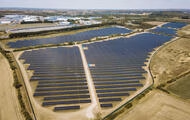How Is JLR Using Solar Power to Transform Its Gaydon Headquarters?
If you’ve ever wondered what a car company’s commitment to sustainability looks like in action, JLR’s latest move at its Gaydon headquarters is a prime example. Picture this: a solar farm sprawling across 26 hectares—the size of 36 football pitches—right next to the heart of Jaguar and Land Rover’s design, engineering, and R&D teams. This isn’t just a flashy PR stunt. It’s a serious step toward energy independence and a cleaner future.
What Makes This Solar Farm Stand Out?
Let’s break down the numbers. The new solar installation at Gaydon packs an impressive 18 megawatts (MW) of capacity. That’s enough to supply a third of the site’s electricity needs. For context, that’s like powering thousands of homes, but instead, it’s fueling the innovation behind some of the UK’s most iconic vehicles.
But the real magic is in the details. By generating such a significant chunk of its own power, JLR is less exposed to the unpredictable swings of the national grid. That means more stable energy costs and a smaller carbon footprint. According to the International Energy Agency, on-site renewables like this are one of the most effective ways for manufacturers to cut operational emissions and future-proof their businesses against rising energy prices.
Why Is On-Site Renewable Energy So Important for Automakers?
The automotive industry is under more pressure than ever to clean up its act. Governments are tightening emissions regulations, and consumers are demanding greener products. For a company like JLR, which has set ambitious net-zero targets, relying on fossil-fuel-heavy grid electricity just doesn’t cut it anymore.
That’s why JLR has committed to sourcing at least 30% of its global energy use from on-site renewables. It’s a bold target, but projects like the Gaydon solar farm show it’s more than just talk. By slashing reliance on external energy sources, JLR is not only reducing emissions but also gaining more control over its operational costs—a win-win in today’s volatile energy market.
Are There Other JLR Sites Going Solar?
Absolutely. The Gaydon project is just the beginning. Over in Wolverhampton, JLR is finishing up one of the UK’s largest rooftop solar arrays. With more than 18,000 panels, this installation will crank out around 9,500 megawatt-hours (MWh) of electricity each year. That’s enough to meet 40% of the site’s energy needs.
And there’s more on the horizon. Next year, JLR’s Merseyside site will see the addition of 10MW solar car ports—think canopies and walkways covered in solar panels, much like those you’d spot in sun-soaked countries like Spain. These aren’t just for show; they’ll provide a dedicated power source for electric vehicle charging, helping to support JLR’s growing EV lineup.
How Do These Projects Impact JLR’s Net-Zero Ambitions?
Sustainability isn’t just a buzzword for JLR. Andrea Debbane, the company’s sustainability chief, put it simply: these projects are crucial because they directly cut global operational emissions and move the company closer to its net-zero goal. But there’s a practical side, too. By investing in renewables now, JLR is delivering real value both today and for the long haul—lowering costs, reducing risk, and building a more resilient business.
What Can Other Manufacturers Learn from JLR’s Approach?
JLR’s strategy offers a blueprint for other manufacturers looking to decarbonize. It’s not about waiting for the perfect moment or the latest technology. It’s about starting with what’s possible—like installing solar panels on unused land or rooftops—and scaling up from there. The outcome? Game-changing reductions in emissions and a more sustainable business model.
A recent report from the UK’s Department for Business, Energy & Industrial Strategy highlights that on-site renewables can cut industrial energy bills by up to 30% over time. That’s a significant saving, especially as energy prices continue to fluctuate.
The Road Ahead: Why This Matters for Everyone
JLR’s solar push isn’t just good news for the company or its employees—it’s a signal to the entire industry. As more automakers take real steps to reduce their environmental impact, the ripple effects will be felt far beyond factory gates. Cleaner energy, lower emissions, and smarter use of resources benefit us all.
So next time you see a Jaguar or Land Rover on the road, remember: there’s a good chance the innovation behind it was powered by the sun. And that’s a future worth getting excited about.

